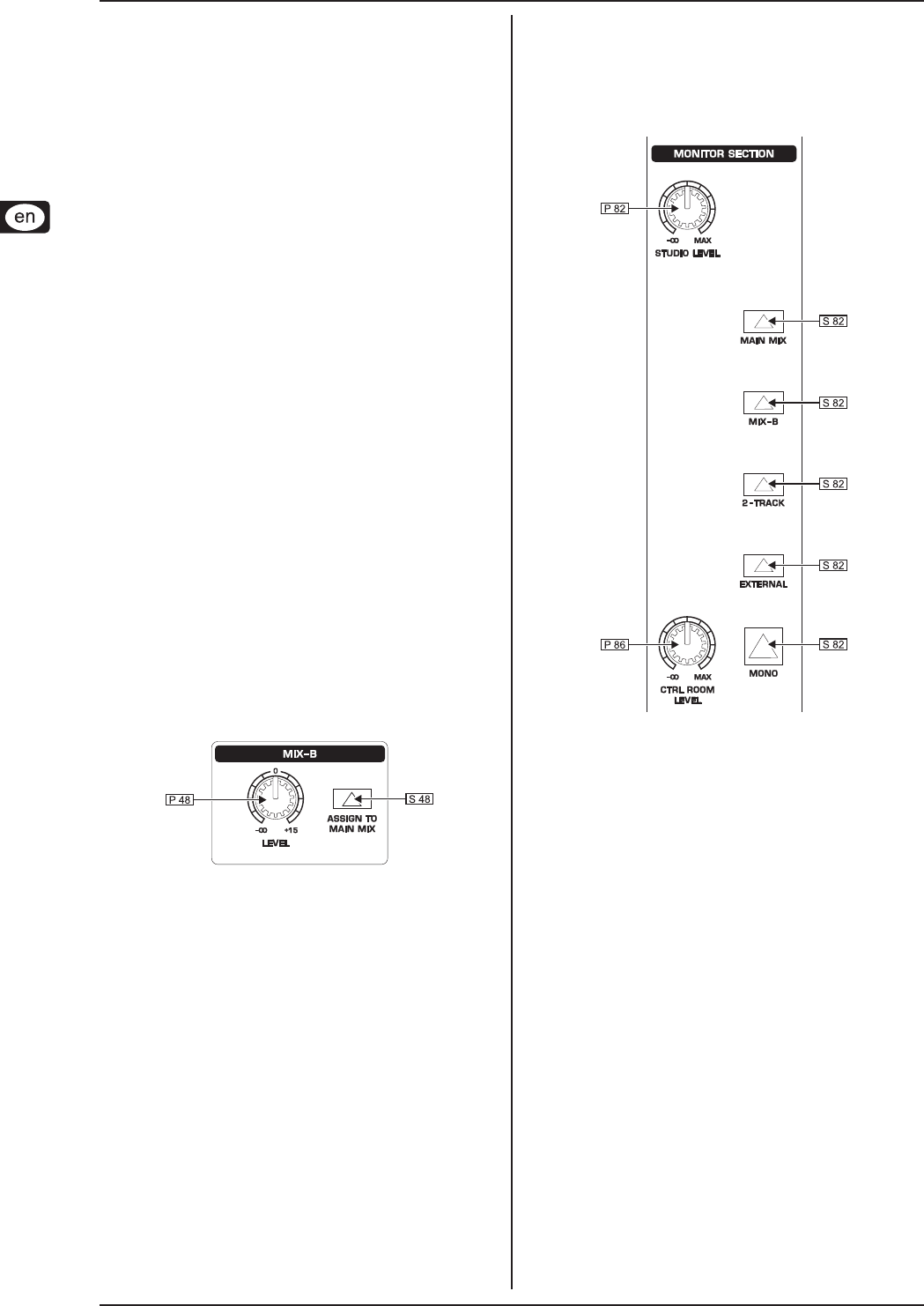
EURODESK SX4882
Master panel10
As always, there are exceptions to the above rule. Some +
short stereo delay effects (say 30 ms to L, 50 ms to
right) cause a psychoacoustic effect where the earlier
delay seems louder. A similar effect is noticeable when
harmonizing in stereo: a slight pitch shift upwards will
seem louder than one that goes down. In both cases use
the BALANCE control (P51) to compensate.
When carrying out the above mentioned information, or +
any other stereo imaging exercise, don’t just rely on the
control room monitors. Get a pair of headphones and
listen in stereo and in reverse stereo, to allow for any
hearing discrepancy between your ears.
b) Aux returns 3 to 6
And so to aux returns 3 through 6. These too have a routing matrix
(S55 to 58 for aux return 3), but this time it is designed to facilitate
monitoring rather than recording. The options are MAIN (L/ R)
MIX, and PHONES 1/2. Gain pots and solo switches complete
the picture.
c) SOLO
Below each column of aux returns lies a local solo LED (L61 &
L74). These illuminate whenever a SOLO button in the column
above is pressed.
There is no absolute reason why the send from aux 1 should
feed into a processor whose outputs are sent to the aux return 1.
The processor could just as easily be patched into the aux return
3, or even a pair of channels. For many purposes, however, it is
sensible to set up a default patch where the aux outputs and inputs
correspond. It is logical to put your premier FX units into the aux
1 and aux 2 loops, since these returns enable you to record to
tape without re-patching.
An exception to the above is when recording a group +
of performers live to multitrack. (See section 16.3 “Wet
monitoring”).
Sometimes an engineer wants to narrow the stereo width +
of a reverb eld. To do this you will have to come back on
either A or B-channels, which have full PAN facilities.
MIX-B master6.2
Mix-BFig. 6.3:
Only two controls occupy the MIX-B master (g. 6.4). P48 offers
the standard EURODESK gain of up to +15 dB. S48 is crucial:
it routes the MIX-B bus output into the main mix bus. MIX-B can
have three basic functions:
It can act as an entirely separate mixer-within-a-mixer to provide
a completely separate mix (S48 UP, S23 DOWN). (See also
section 17.)
It can act as an additional stereo aux feed to FX as well as a pre
fader monitoring aid during mixdown (S48 UP, S23 DOWN).
It can provide 24 extra B-inputs to the mix (S48 DOWN, S23
UP).
For live applications try using MIX-B to feed a secondary +
set of speakers. These could be sidells, or even more
spectacular, the rearward portion of a quadraphonic
sound system.
There is no SOLO provision for MIX-B. However, you can audition
it by selecting only MIX-B (S83) in the monitor sourcing matrix.
If MIX-B is assigned to the main mix (S48 DOWN), do not +
listen to MIX-B (S83) and the main mix (S82) simultane-
ously. That way you’ll be monitoring MIX-B twice over,
and what you hear won’t correspond with what’s going
down to tape.
Monitoring6.3
MonitoringFig. 6.4:
Though most of you will want to audition the main mix most of
the time there are exceptions. These include PFL/SOLO, and
2-TRACK PLAYBACK. The SOURCING matrix (S82 to S85, see
g. 6.5) allows you to monitor the main mix, the MIX-B and two
external sources marked 2-track and EXTERNAL. The master
meters follow whatever source is being auditioned. The meters
won’t make much sense if more than one source is selected!
EXTERNAL could be “normalled” to a HiFi pre-amp, +
allowing you to monitor extra sources such as vinyl,
cassette, CD, etc.
Altering what goes into the control room’s monitors +
does not affect the signal from the main recording out-
puts. Just as well, or every time you wanted to do a quick
SOLO during a mix, you’d have to start again!
The CONTROL ROOM LEVEL pot P86 sets the level to the control
room monitors. This is sourced post the main main mix stereo
fader setting: otherwise you wouldn’t be able to hear your fades.
There is also a similar STUDIO volume pot (P82).
Owners of MIDI production suites might like to drive a +
second pair of control room speakers from the studio
output, but take care when using the TALKBACK mic:
no -20 dB offset is applied to the studio output!
We would like to recommend you to use half-a-dozen sets
of speakers on an external switching matrix, including studio
monitors, ghettoblaster, club system, car stereo and overblown
2" speakers loosely screwed into a less-than-airtight cardboard
box.


















